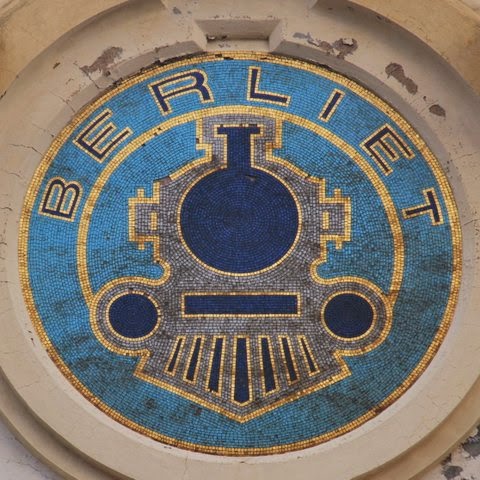A long wall interspersed by many tall windows and just as many rainwater
pipes stretches most of the way along Rue Feuillat between Cours Albert Thomas
and Avenue Lacassagne in the 3rd Arrondisement. Halfway down, an imposing stone
gate with intricate ironwork and stained-glass clear denotes what must once
have been the main entrance. Peering through the smashed safety glass of the
windows, you can still see an elaborate iron roof and get a sense that this was
once something big.
Big it was indeed. The stepped walls enclose a behemoth of a site spanning 75,000m² and employing nearly two thousand people in its heyday. For this is the oldest existing car factory in Lyon, although the grounds have changed hands many times over the last century.
Big it was indeed. The stepped walls enclose a behemoth of a site spanning 75,000m² and employing nearly two thousand people in its heyday. For this is the oldest existing car factory in Lyon, although the grounds have changed hands many times over the last century.
 | |||
| Entrance to the Rochet-Schneider factory, 1911 (Photo courtesy Fondation Berliet) |
The factory was designed and built in 1899 along what was then Chemin
Feuillat by industrial architect Louis Payet to house the workshops of the fledgling
though highly successful car company of Edouard Rochet and Théodore Schneider.
The site was soon the talk of the town, a "model" factory hailed as
one of the most important industrial sites worldwide at the time.
Cleverly stepped so that the ground was on a single level along its
entire 510-metre length, the wrought-iron superstructure featured sloping
glass-and-metal rooves and light, airy "sheds" broken up by iron
pillars at only 12-metre intervals. Covered avenues running along inside the
factory were so broad that two lorries could comfortably pass one another. The
factory boasted state-of-the-art machinery and employed lean production
methods. And in another novelty, two large underground galleries safely
distributed steam, gas and electricity to wherever they were needed.
 |
| Aerial view of Rochet-Schneider factory on Rue Feuillat (Photo courtesy Fondation Berliet) |
Within a few years, Rochet-Schneider had become one of the world's top ten
automobile manufacturers. Its cars were especially adept at scaling hilly
terrain, justifiably earned the nickname "the French Rolls-Royce". By 1902,
it was exporting to the US and selling licenses to Switzerland and Italy. For
the next three decades, Rochet-Schneider would build the finest cars in Lyon –
if not all of France.
 |
| The Zénith "Z" is still clearly recognisable on the gate |
Meanwhile a Lyonnais engineer called François Baverey was putting the
finishing touches to a revolutionary new carburettor, which he patented in
1906. Schneider and Rochet gave Baverey access to their laboratory and allowed
him to test his "Zénith" carburettor on their cars. By 1908, all
Rochet-Schneider vehicles were fitted with it. The following year, the Société
du Carbureteur Zénith was formed, almost entirely with Rochet-Schneider money.
The two companies' fortunes would be intertwined symbiotically from then
onwards.
Zénith proved such an overwhelming success that more and more space at the
Feuillat plant was given over to producing its carburettors, which were
eventually making far more money than Rochet-Schneider's car business was.
Henry Ford was so impressed by Baverey's carburettor that he ordered it
installed in all his cars. And in 1919, fully two-thirds of the vehicles at the
Paris Auto Show were fitted with Zénith carburettors.
 |
| (Courtesy Fondation Berliet) |
Due to this overwhelming demand, the Feuillat factory had to be expanded
twice, first in 1910-1912 – when the monumental gate was added – and then again
in 1918. As a result, it was churning out 110,000 carburettors a month by 1928,
even though Zénith had opened additional plants in Paris, London, Berlin,
Brussels, The Hague, Milan and even Detroit.
 As Zénith's fortunes rose, those of Rochet-Schneider dwindled. After the
First World War, the car-maker was hit by a triple whammy of the Depression,
the global stock market crash and ever increasing competition from rival auto manufacturers.
With fewer and fewer people able to afford its luxury cars, Rochet-Schneider ceased
being profitable in 1930 and was forced to switch entirely to making busses and
trucks in 1933, although these were on a par with those of another Lyonnais
truck manufacturer, Marius Berliet.
As Zénith's fortunes rose, those of Rochet-Schneider dwindled. After the
First World War, the car-maker was hit by a triple whammy of the Depression,
the global stock market crash and ever increasing competition from rival auto manufacturers.
With fewer and fewer people able to afford its luxury cars, Rochet-Schneider ceased
being profitable in 1930 and was forced to switch entirely to making busses and
trucks in 1933, although these were on a par with those of another Lyonnais
truck manufacturer, Marius Berliet. |
| Inside the main entrance of Zénith, 1913 (Photo courtesy Fondation Berliet) |
World War II dealt another blow to Rochet-Schneider, and by 1951 the
company had stopped vehicle production altogether. But rather than sending its
entire workforce into unemployment, the company operated as a sub-contractor for
others. Its sheds were used for storage.
It was at this stage that rival Berliet stepped in, first renting the
Rochet-Schneider site for its own use and eventually acquiring the company
itself in December 1959, using the site for its spare parts and after-sales department. Three years later, Zénith sold its part of the site to
Berliet and moved its operations elsewhere.
 |
| The Berliet logo |
Over the next decade, Berliet and the factory passed from one owner to
another as the French auto industry consolidated. In June 1967, Berliet voluntarily joined Citroën (then owned by tyre manufacturer Michelin) in order to develop a European-level car and truck group. Then, in 1974, Renault acquired Berliet when Peugeot acquired Citroën as part of a government-approved restructuring of the industry. Six years later, in 1980, the name
Berliet disappeared completely when Renault merged Berliet with its Saviem
division to create Renault Véhicules Industriels (RVI, though since renamed Renault Trucks). The Feuillat site was
relegated to a warehouse for spare parts.
In 1998, almost exactly a century after Payet built the original factory
for Rochet-Schneider there, RVI closed the Feuillat site altogether and moved
its storage facilities to Renault's far larger and newer complex in Vénissieux.
Just over half of the land (41,000m²) was sold to a developer to build a
vocational training centre in 2000, while the remaining 34,000m² were bought by
Grand Lyon.
 |
| Inside what's left of the Rue Feuillat factory |
Whereas the newly-erected training centre, the SEPR, opened its
doors in 2004, questions remained about what to do with the rest, which was clearly
too architecturally significant to simply tear down. Briefly used to host an
art festival in 2001, a number of ideas were mooted, including setting up a
technology museum and making the space available for SMEs. In somewhat late
recognition of its significance to French industrial history, the remaining
"sheds" and main gate along Rue Feuillat were declared a national
monument.
In 2003, the city of Lyon took the rather bold move of officially
authorising artists to occupy the splendid vacant buildings, prompting them to
form a self-governing non-profit organisation, the Collectif Friche Autogérée RVI. At its height, some 400 painters, sculptors, musicians, photographers and
dancers had set up studios in the well-lit, airy buildings.
 However, the century-old walls and rooves were rapidly showing their
age, and no longer met the necessary safety regulations. The collective was
therefore permitted to admit the public only during the annual National
Heritage Days, thus considerably limiting the scope of its activities. By
mid-2010 the state of the buildings had deteriorated to such an extent that the
city decided to close the friche (former industrial area). The artists
and some 50 squatters who were living there illegally were therefore given six
months to move out. The collective was still fighting this eviction when a
major fire broke out on 10 December, gutting two-thirds of the buildings and
bringing an abrupt end to the daring social experiment.
However, the century-old walls and rooves were rapidly showing their
age, and no longer met the necessary safety regulations. The collective was
therefore permitted to admit the public only during the annual National
Heritage Days, thus considerably limiting the scope of its activities. By
mid-2010 the state of the buildings had deteriorated to such an extent that the
city decided to close the friche (former industrial area). The artists
and some 50 squatters who were living there illegally were therefore given six
months to move out. The collective was still fighting this eviction when a
major fire broke out on 10 December, gutting two-thirds of the buildings and
bringing an abrupt end to the daring social experiment.
Since then, the once-glorious site has been boarded up and left to rot,
its windows smashed, its wrought-iron superstructure exposed to the sky.
But all has not been lost. The collective and the frichards may be
gone, but graffiti artists have taken on the artistic mantle, drawing
inspiration from the industrial architecture as well as the massive canvasses
provided by the former factory's inner walls to spray a stunning collection of
larger-than-life artworks that I encourage anyone to go and experience while
they still exist.
 |
| One of the many graffiti in the abandoned factory |
Grand Lyon also has plans for the site. Over the next few years, a small
park is to be set up in the north-eastern section. The rest is to be developed
into a library, council flats, a gym and student accommodation. The vast façade
along Rue Feuillat and the monumental gate – the last vestiges of the history
of the Lyonnais auto industry – are to be renovated and preserved for
posterity.













Berliet Trucks Logo-Symbols 3D Pictures
ReplyDelete